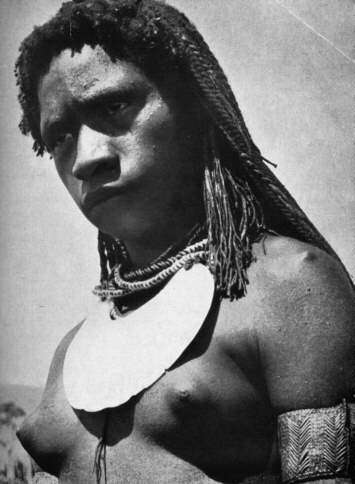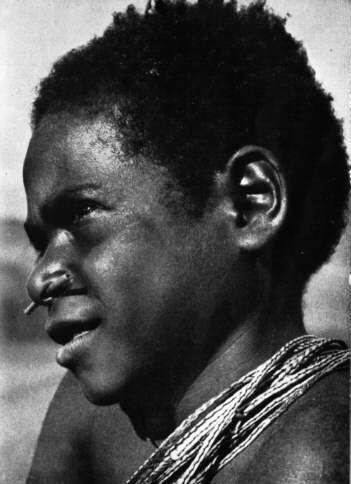
|
|
| Cannibal Culture | |
|
Selected excerpts from Jens Bjerre’s The Last Cannibals on primitive beliefs and customs New Guinea |
Cannibal Courtship and Customs (2)
Let us take a closer view of these Kumans. Before us stretches a great valley dotted with villages and with fields and clearings laid out on the neighbouring hillsides, below the belt of jungle and forest. Higher up the mountains in the region of the Chimbu and Wighi valleys there are 60,000 to 80,000 people divided into twenty main clans. These again are divided into sub-clans composed of several villages each of which is, in effect, a large family group. A sub-clan is thus an association of families with its own songs and stories, its own feasts and ceremonies. Each sub-clan has a chief; a man of strength and authority who must, however, consult the older men of the clan about all decisions. Each village is a group of settlements where the land is cultivated by the women who grow the usual root crops, mostly sweet potatoes and vegetables. They also look after the family pigs. The men gather fuel, sometimes go hunting and organize the frequent ceremonies and feasts; apart from that they pass the time gossiping with each other. Each family settlement consists of several huts. One of these is a round, communal dormitory hut where the male members of the family sleep at night; there is also a smaller oblong hut divided in two, where men and women, separately, seek shelter during the day against the rain and the cold. Apart from that there may be one or more huts for the women.

The Kumans normally have only one wife, but there is nothing to prevent a man from taking an extra wife except that he must provide each wife with a hut and a field. It is a matter of prestige to have as many children as possible. The Kuman women, as a rule, dislike polygamy, and use violence, as well as witchcraft, to get rid of a rival. A wife is regarded as her husband’s property. He is permitted erotic experiences outside marriage; she is strictly forbidden to do so without her husband’s permission. If, with his consent, she receives payment for her sexual services to other men she must hand it over to her husband. But there is little sexual excess among the Kumans, even during their wild dancing ceremonies.
It was amusing to notice that the men who visited their wife or wives too often were grossly teased by the other men. The reason for this is that the men like to have as many children as possible so as to enhance their wealth and position and, according to the Kuman’s belief, a man must sleep with his wife many times running in order to make her pregnant. They believe that the man, by these protracted endeavours, transfers the whole child to the woman’s body. The women, on the other hand, are not at all inclined to have many children, so they take precautions or induce abortions. It is usual for young girls on marriage to receive from their mother advice and instructions about avoiding pregnancy for the first three or four years of marriage. They eat certain roots and leaves for this purpose and also repeat magic incantations which they believe to be effective.
When a child is about to be born the husband builds a little shelter near the woman’s house. If the birth is difficult a witch-doctor is called to recite magic incantations as well as to give massage. Men must not be present at the birth but the mother’s other small children are allowed to witness it and thus become familiar with birth from their earliest childhood. Here stories about the stork are not necessary. Two or three days after the birth the neighbouring families come to the mother’s house for a little celebration. The father beaming with pride at what he believes is solely his achievement, kills and prepares a pig of which he gives the first portion to the mother. The second course is usually a sort of pudding made of bananas and sweet potatoes. A sorceress invited to take part in the feast touches the food with two sticks and recites a blessing...

Girls remain with their mother until they marry, but boys move over to the men’s hut when they are seven or eight years old, and already at that tender age begin hunting small game and trying their hands at other manly duties.
When a boy is about ten he goes through the initiation ceremony. As a rule this happens within the family circle, but if there are several boys of the same village, due for initiation, the joint ceremony is held during one of the big village feasts, as it is also among the Morombos. The night before the nose boring is to take place, the young initiate sits with the men of the family in the men’s hut and is schooled in his future duties and behaviour. He hears, for the first time, some of the myths of the clan and some of the men’s cherished secrets. One of these is how to play the magic flute, an instrument like the tumbu-lun of the Kukukukus, used to strike terror into the women. The men of each family share one of these flutes. On this night of preparation the flute is played, outside the hut, by the boy’s father or older brother; then it is brought in and explained to him, and he begins forthwith to learn how to play the family tunes upon it. It is impressed upon him that he must never show the flute to any woman. Women and children are told that the flute represents a large bird which lays its eggs on a great stone in the jungle, and if they should happen to see the koa, they would be struck blind, their bodies would rot and their pigs perish. If you ask the Kumans why they tell their women and children such a fanciful yarn, they reply:
‘If we showed our flutes to the women, they would only laugh at us and they would refuse to believe that we control the guardian spirits with them. We should lose our authority, our women would no longer cook our food and tend our pigs.’
Next morning the boy is taken deep into the jungle, where the nose boring is performed in the same way as among the Morombos. The following day there is a great feast during which, on a given sign, the initiated boys come dashing on the scene with sticks through their noses, their bodies glistening with pig fat and painted in bold colours. They brandish their spears and bows with joyous shouts – and the feast is really on.
The girls, too, are initiated. At the first sign of maturity a four-day ceremony is held in the mother’s hut during which all the older women of the family gather and tell the girl how to behave towards men and how to practise the basic laws of the tribe. On the final day a symbolic cleansing occurs after which the girl is considered adult. The women sit on in the hut far into the night and chant songs about the duties of women and the grandeur of nature...
Jens Bjerre, The Last Cannibals, Michael Joseph, 1956 pp. 126-130